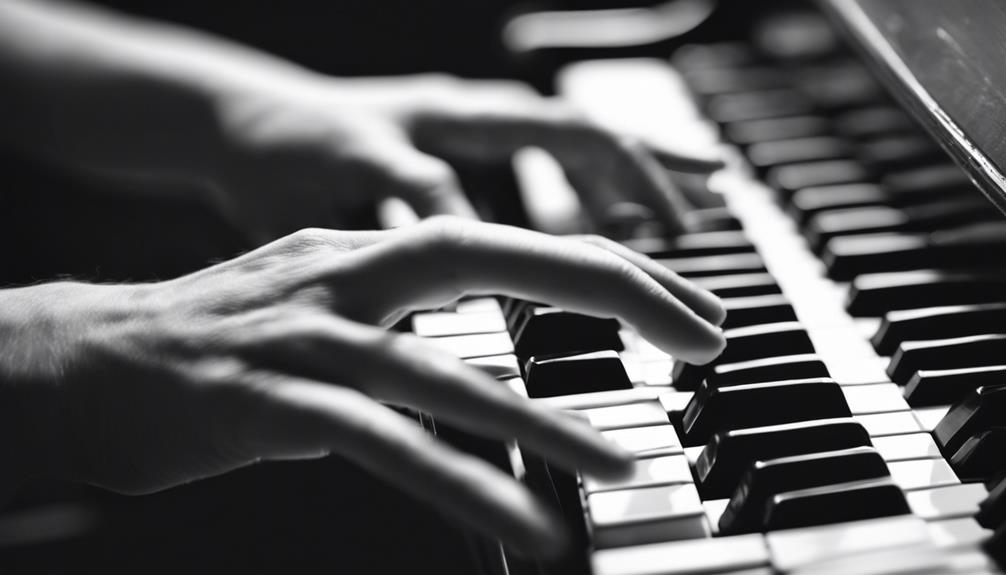When you’re just starting to play the piano, it’s important to first understand the basic layout of the keys and how they correspond to musical notes. You’ll find that the white keys represent natural notes, while the black keys are for sharps and flats. Identifying middle C as your central reference point will help you navigate the keyboard more easily.
Next, you’ll need to focus on proper finger placement and hand posture to make sure you’re building good habits from the beginning. But that’s just scratching the surface—there are several more foundational steps you’ll need to master before you can truly enjoy playing.
TL-DR
- Learn the layout of the 88 piano keys, using Middle C as a reference point.
- Practice finger placement, assigning numbers to fingers for correct technique and hand posture.
- Understand basic sheet music symbols like treble clef, bass clef, note values, and time signatures.
- Use a metronome to develop a solid sense of rhythm and improve timing.
- Start with scales and simple tunes to build finger coordination and muscle memory.
Understanding Piano Basics

Understanding the piano’s 88 keys, which include both white and black keys, is the first step in learning to play piano. Each key represents a unique music note, forming the foundation for melodies and harmonies. Your central reference point on the piano is Middle C. This key lies at the midpoint of the keyboard and helps you locate other notes with ease.
When reading sheet music, you’ll notice the grand staff, which consists of two primary components: the treble clef and the bass clef. The treble clef is for higher-pitched notes, typically played with your right hand, while the bass clef covers lower-pitched notes for your left hand. Together, these clefs help you navigate the full range of piano keys and octaves.
Recognizing the relationship between these music notes and the corresponding keys is essential. Start by identifying Middle C on both the piano and the grand staff. From there, you can practice scales and simple tunes, gradually becoming comfortable with the keys and notes.
As you progress, you’ll find it easier to interpret music and play more complex pieces. By mastering these basics, you’ll be well on your way to becoming a proficient pianist.
Familiarizing With Piano Keys
How can you effectively familiarize yourself with the piano’s 88 keys? Start by understanding the keyboard layout. The piano keys consist of both white keys and black keys arranged in a repeating pattern. The white keys represent the natural notes (A, B, C, D, E, F, G), while the black keys are used for sharp and flat notes and are grouped in sets of twos and threes.
Middle C is your central reference point. It’s typically located near the center of the keyboard and serves as a landmark to help you navigate the piano keys. By identifying Middle C, you can better understand the relationship between notes.
Here’s how you can get comfortable with the keyboard layout:
- Identify Patterns: Notice the repeating pattern of black keys (groups of twos and threes) and use them to find white keys.
- Locate Middle C: Find Middle C on your keyboard to have a consistent reference point.
- Understand Sharps and Flats: Recognize that black keys represent sharp and flat notes—C# (C sharp) is the black key right after C.
- Practice Scales: Play scales to understand the relationship between notes and how they move across the keyboard.
Learning Finger Placement

Now that you’re familiar with the piano keys, it’s important to understand basic finger numbering and hand position techniques.
Start by assigning numbers to your fingers, with the thumb as number 1 and the pinky as number 5.
Practice these techniques regularly to improve your accuracy and playing speed.
Basic Finger Numbering
Mastering basic finger numbering is essential for efficient and accurate piano playing. Each finger on your hand is assigned a specific number to facilitate seamless coordination and accuracy. Your thumb is finger 1, index finger is 2, middle finger is 3, ring finger is 4, and your pinky finger is 5. This consistent numbering helps you follow sheet music and instructions more easily.
Using the correct finger numbers isn’t just about following rules; it’s about building a foundation for proper technique and good hand posture. By sticking to the finger numbering system, you’ll find it easier to play scales, chords, and melodies smoothly. This method also promotes better muscle memory and reduces the risk of injury.
Here’s a quick guide to help you remember the finger numbers:
- Thumb (Finger 1): Use it for keys closest to your body.
- Index Finger (Finger 2): Great for adjacent keys, providing support.
- Middle Finger (Finger 3): Central for balance and strength.
- Ring Finger (Finger 4): Assists in playing more complex chords.
- Pinky Finger (Finger 5): Reaches keys farthest from your body.
Following these basic principles will set you up for success as you continue to learn and play the piano.
Hand Position Techniques
Proper hand position on the piano, with fingers curved and relaxed, is essential for developing control and flexibility in your playing. Start by ensuring that your hand position is correct: your fingers should be gently curved and your wrists level with the keys. This proper technique allows you to maintain relaxed fingers, which helps prevent tension.
Your thumb position is important. Place your thumb (first finger) on the lower notes, usually those closest to the center of the keyboard. The rest of your fingers follow in a natural curve, with the index finger (second finger) next, then the middle finger (third finger), ring finger (fourth finger), and finally the pinky finger (fifth finger).
This effective finger placement makes it easier to reach all keys comfortably. Regular practice of these finger placements helps develop muscle memory, allowing you to play more fluently and accurately. The pinky finger often reaches the outer keys, while the thumb stays on the lower end.
Reading Sheet Music
To read sheet music, you need to understand symbols like the treble clef, bass clef, note values, time signatures, and key signatures. These elements are the building blocks of Piano Sheet Music.
- Treble Clef and Bass Clef:
The treble clef, used for higher pitch notes, and the bass clef, used for lower pitch notes, are essential for identifying which notes to play with your right and left hands, respectively.
- Note Values:
These indicate the duration of each note. Whole notes, half notes, quarter notes, and so on help you understand the rhythm and timing of the piece.
- Time Signatures:
Found at the beginning of a piece, these numbers indicate how many beats are in each measure and what note value (e.g., quarter note) gets the beat. Common time signatures include 4/4, 3/4, and 6/8.
- Key Signatures:
Located right after the clef signs, key signatures tell you the key of the music and which sharps or flats you’ll need to play consistently throughout the piece.
Practicing Scales

After getting comfortable with reading sheet music, it’s important to start practicing scales to build finger coordination and muscle memory. Scales are sequences of notes played in ascending or descending order. They’re fundamental for understanding key relationships and improving your overall dexterity on the piano.
Begin with the basic C major scale. It’s simple as it involves only white keys, making it perfect for developing initial finger coordination. As you practice, focus on the evenness of sound. Each note should be clear and consistent, without any sudden loud or soft notes. This helps in building muscle memory, allowing your fingers to move smoothly across the keys.
Once you’re comfortable with C major, gradually progress to more challenging scales that include sharps and flats, like G major or A minor. Practicing these scales will deepen your understanding of different key relationships and further enhance your playing skills.
Playing scales with both hands together is essential for improving hand coordination. Start slow, ensuring that each hand plays the notes evenly. Over time, increase your speed while maintaining accuracy and consistency. Regular scale practice lays a solid foundation for playing piano, making more complex pieces easier to tackle.
Playing Simple Chords
Learning to play simple chords is a fundamental step that will greatly enhance your piano playing skills. Simple chords are made up of three notes played together, creating a harmonious sound.
As a beginner, you’ll start with common major chords like C major and G major, and minor chords such as A minor and E minor. Knowing these basic chord shapes and finger placements is essential for your progress.
To make learning these simple chords easier, follow this guide:
- Learn How to Play Basic Chord Shapes: Begin with major and minor chords. Place your fingers correctly to guarantee smooth shifts.
- Practice Chord Progressions: Move between chords like C major to G major, then A minor to E minor. This helps improve fluency and accuracy.
- Understand Music Theory Basics: Knowing why chords sound good together can deepen your understanding. This knowledge will make playing the piano more intuitive.
- Start Playing Around with Chords: Experiment with different combinations and see how they sound. It’s a fun way to get creative and improve your skills.
Using a Metronome

Mastering the piano’s rhythm and timing becomes much easier with the aid of a metronome. This device provides an audible click or beep at a set tempo, guiding your timing as you play.
When you’re just starting, a metronome can be invaluable in helping you develop a solid sense of rhythm. Begin by setting the metronome to a slow, manageable tempo and practicing simple exercises. This foundational practice will help you stay on beat and build a consistent pace.
As you become more comfortable, gradually increase the tempo. This incremental speed change challenges your timing and enhances your accuracy. You’ll notice that your ability to play smoothly and with precision improves over time. Using a metronome not only aids in keeping a steady tempo but also helps in achieving a more professional sound.
Incorporate the metronome into your daily practice sessions. Whether you’re working on scales, chords, or full pieces, the metronome can make sure that you’re maintaining the correct rhythm. Consistent practice with this tool will lead to noticeable improvements in your speed and accuracy, making your overall piano playing more polished and enjoyable.
Setting Practice Goals
Setting practice goals is essential for keeping you focused and motivated on your piano learning journey. When you set specific, achievable goals, you can see tangible progress, which can be incredibly encouraging for beginners. Breaking down larger objectives into smaller milestones makes the learning process manageable and helps maintain your enthusiasm.
Here are some key steps to effectively set and achieve your piano practice goals:
- Define Clear Objectives: Identify what you want to achieve, whether it’s learning a new song or mastering a specific technique. Clear goals will guide your practice sessions and make them more productive.
- Break Down Goals: Divide your main objectives into smaller, achievable tasks. For instance, if your goal is to learn to play a song, break it down into sections like mastering the intro, verse, and chorus separately.
- Track Your Progress: Keep a practice journal or use a progress tracking app. Recording your achievements helps you see how far you’ve come and where you need to focus more.
- Regularly Reassess Goals: As you make progress, revisit and update your goals. This maintains continuous development and keeps your practice routines aligned with your evolving skills.
Improving Technique

Now that you’ve set your practice goals, let’s focus on improving your piano technique to enhance your overall playing skills. One of the first steps to learn the piano more effectively is to practice scales. Scales are important for building finger dexterity and understanding key relationships. Start with simple scales and gradually increase complexity as you progress.
Playing with both hands can be challenging, but it’s essential for improving technique. Begin by mastering each hand’s part individually before combining them. This approach helps you focus on accuracy and timing, making sure that both hands work in harmony.
Smooth connections between notes are essential for fluid playing. Practice linking notes seamlessly to avoid any abrupt breaks in your music. Work on mastering measures individually to ensure precision before attempting to play the entire piece. This tactic allows you to break down the song into manageable sections, making it easier to perfect.
Building muscle memory is another key aspect of improving your technique. Repetitive practice ingrains movements into your muscles, allowing you to play more effortlessly over time. Focus on accuracy and timing during your practice sessions to maintain the song’s rhythm and enhance your overall performance.
Exploring Music Genres
Exploring different music genres can greatly broaden your piano playing skills and deepen your appreciation for diverse musical styles. When you’re learning to play, delving into various genres can open up a world of possibilities and enrich your musical journey.
- Classical Piano: Start with classical piano to grasp intricate compositions by renowned composers like Beethoven and Mozart. This genre will enhance your technical abilities and understanding of complex musical structures.
- Jazz Piano: Jazz piano involves improvisation, syncopation, and unique chord progressions. It encourages creative expression and can improve your ability to play by ear, making you a more versatile pianist.
- Popular Songs: Learning popular songs is essential for playing catchy melodies and simple chord structures. These easy piano songs are perfect for beginners and can be a fun way to impress friends and family.
- Worship Music: Playing worship music on the piano focuses on creating a spiritual and uplifting atmosphere. This genre emphasizes chords and harmonies, helping you develop a sense of rhythm and emotional expression.
Exploring music genres not only diversifies your repertoire but also helps you discover what resonates most with you. Delve into these genres and expand your piano horizons!
Next up, learn all about piano intervals, scales and modes in this guide.
